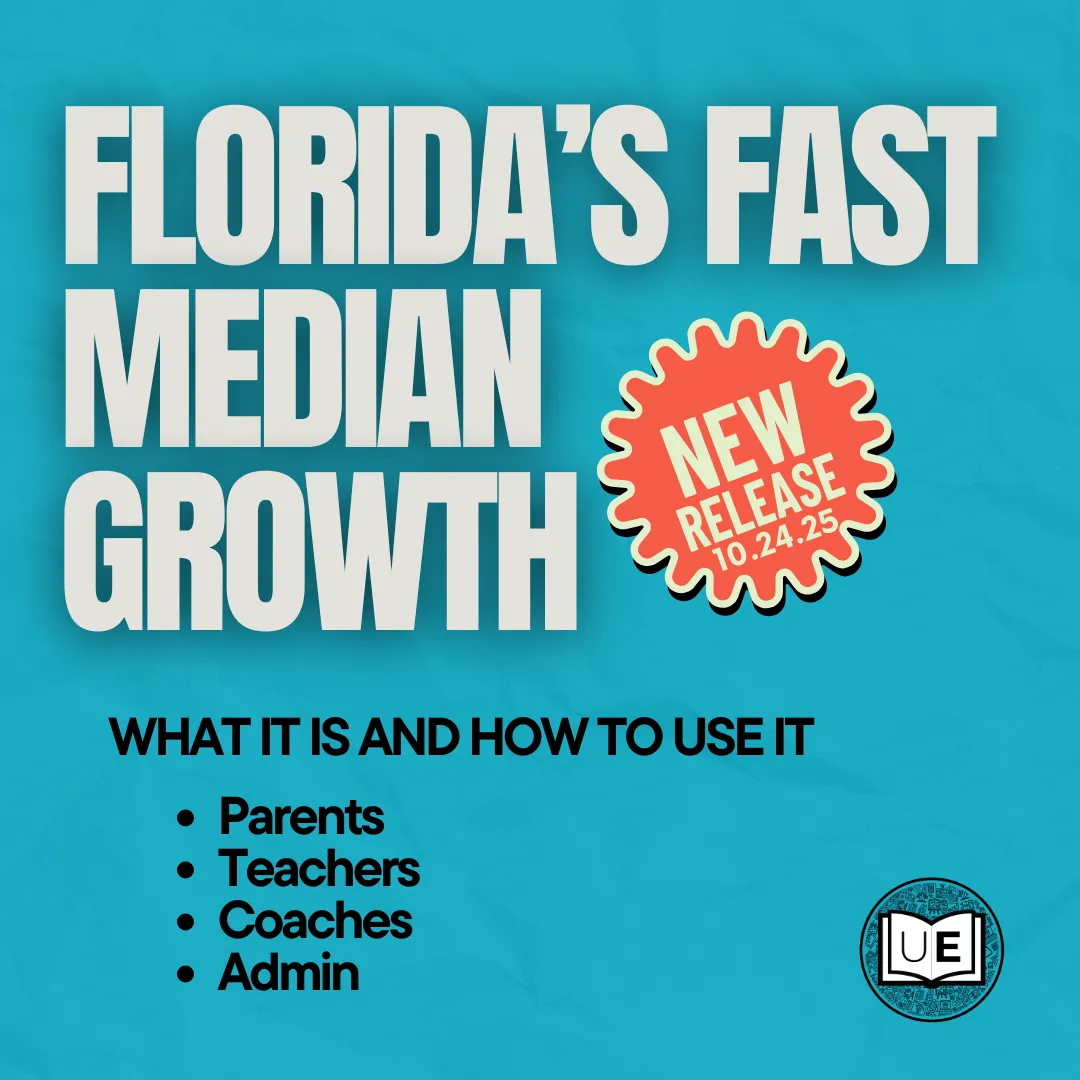
FAST Median Growth: What It Means and What To Do Next
The Gist:
Florida published "FAST Median Growth 2025-2025" on October 24, 2025.
Median growth is the middle amount of scale-score change students showed between progress checks (PM1 to PM2, PM2 to PM3, PM1 to PM3).
It is a statewide descriptive reference, not a target.
Use it to put student changes in context for those who started in the same place, then plan instruction.
K–2 uses the FAST Equivalent Scale for median growth (not the Unified Scale).
Download our quick guide by CLICKING HERE.
What “median growth” is and what it is not
What it is: The median of scale-score gains between PMs, reported by a student’s prior achievement level. It tells you what a typical change looked like for similar starters statewide.
What it is not: It is not “expected,” “sufficient,” or an accountability target. Students who start below grade level usually need more than median growth to reach Level 3 (and true proficiency at Level 4).
K–2 note: K–2 values are on the FAST Equivalent Scale.

Parents and families: how to use it
Ask how your child’s score changed between PMs compared to students who started at the same level. That is the fairest reference point.
If your child started below grade level, plan for above-median growth. Ask for the next skill focus and a simple at-home routine you can keep up each week.
Download our quick guide by CLICKING HERE.
Conversation starters
“What skills come next before PM3?”
“What can we practice at home each week to help?”
Classroom teachers: how to use it in planning
On a spreadsheet, sort scores by prior level (L1 to L5). Compare each student’s PM change to the table medians for your grade, subject, and level. That gives you below, near, or above typical movement.
Plan responses:
Below median, especially L1–L2: tighten core routines, add daily retrieval on prerequisites, add brief small-group minutes.
Near or at median: keep momentum and add problem variety so gains stick.
Above median: extend with complexity, written explanations, and mixed practice.
Do not overreact to tiny or negative shifts at high levels. Check overall level and evidence of mastery before you chase points.
Download our quick guide by CLICKING HERE.
Instructional coaches: how to use it to target support
Build a simple heat map by class or grade. Track the percent below, near, and above the median by prior level. This separates Tier 1 adjustments from Tier 2 needs.
Match moves to gaps. Retrieval and fluency bursts for Levels 1–2. More complexity, text or problem variety, and writing for higher levels.
Work in short 2–3-week cycles with quick checks so teachers can see movement before PM3.
Download our quick guide by CLICKING HERE.
Coach language to normalize the tool
“Median shows typical statewide movement for kids who started in the same place. If we need to close gaps, we will aim above that.”
School and district leaders: how to use it at the systems level
Set the norm: median growth is descriptive, not prescriptive. Use it to give context, not to rank teachers.
Prioritize resources where many below-level students are also below the median. Direct coaching time, Tier 2 minutes, and aligned practice there.
Calibrate communication. Remind teams that students below grade level usually need above-median growth to reach Level 4.
Download our quick guide by CLICKING HERE.
Quick examples you can reuse
Teacher to a parent: “From PM1 to PM2, your child gained 9 points. Statewide, students who started at the same level gained about 8. That is right around typical. Next, we will work on multi-step problems to keep momentum.”
Coach in a PLC: “In Grade 4 Math, what percent of Levels 1–2 are below the PM1 to PM2 median? We will pick two prerequisite skills for daily retrieval and re-check in two weeks.”
Principal to staff: “Median is a reference point, not a mandate. For students below grade level, we will aim above the median to reach Level 4.”
Need help turning growth into action?
Reading Comprehension Roadmaps | Florida B.E.S.T. Standards give teachers a simple, step by step way to teach the skills that drive comprehension.
Math Roadmaps are coming soon. They organize benchmarks into teachable skills with a clear order of learning.
Live training for teachers or coaches helps teams plan, practice, and leave with ready to use tools.
Ongoing series builds habits over time with short cycles, quick checks, and real classroom moves.
Consultation pairs you with an expert from our team to make a short plan for next steps.
When you're ready to talk through what fits your school, reach out to our team or reply and ask for dates and pricing. [email protected]
P.S. for principals
If you want this ready for your next data meeting, ask for the one-hour team session or a short consult.
FAQs
Can median growth tell me if a student will hit Level 4?
No. It is a descriptive baseline. Students who start below level usually need more than the median to catch up.
What does Level 3 really mean?
Level 3 is what the state calls "on grade level." However, it is not full proficiency.
What does Level 4 mean?
Level 4 is proficient. It shows mastery of the grade-level benchmarks. Level 4 needs to be the ultimate minimum goal full understanding of grade level material.
So, is Level 3 good enough?
Level 3 means the student is "on grade level." For many kids, especially those who started below level, our aim is steady growth into Level 4, so they are not just meeting the bar but showing strong proficiency. Use median growth to give context, then plan instruction that moves students toward Level 4 over time.
Where do I find the medians for my grade and subject?
In FDOE’s FAST Median Growth 2025–2026 PDF. Tables list PM1 to PM2, PM2 to PM3, and PM1 to PM3 by grade and prior level.
What changed from last year's median growth to this year's?
The 2025–26 release adds K–2. Last year only showed grades 3–10. K–2 medians sit on the FAST Equivalent Scale (not the Unified Scale). The specific median values for grades 3–10 also shifted a bit by grade, subject, and prior level. Small up or down moves are normal year to year. To view last year's median growth, click here.
Why might the medians shift year to year?
They are based on the prior year’s statewide results. When cohorts, instruction, or test timing change, the middle amount of score change can move a point or two. Treat the medians as fresh reference points each year, not fixed targets.
How should I use this year’s medians?
Use the 2025–26 tables when reading PM1 to PM2 and PM2 to PM3 this year. Compare students' scores to the median for their prior achievement level, in their grade and subject. If a student started below grade level, plan for growth above the median.
Did the core message change?
No. Median growth is descriptive. It tells you what typical statewide movement looked like for students who started in the same place. It is not an expected or sufficient goal. Students below grade level usually need more than the median to reach Level 4.
Sources
Florida Department of Education, Office of Assessment. FAST Median Growth 2025 to 2026. October 2025. FAST Median Growth
Florida Department of Education. FAST Grades 3 to 10 Fact Sheet (2025 to 2026). Explains the assessment system and reporting basics. 2025-26 FAST Grades 3 through 10 Fact Sheet
Florida Department of Education. Understanding Florida Statewide Assessments Reports for Families (2025 to 2026). Shows the five achievement levels and labels Level 3 as on grade level and Level 4 as proficient. Understanding FSA Reports for Families_25-26_FINAL_080725.pdf
Florida Department of Education. B.E.S.T. Standards Achievement Level Descriptions. Notes that Level 3 indicates on grade level and Levels 4 and 5 indicate proficiency beyond Level 3 expectations. B.E.S.T. Standards Achievement Level Descriptions

